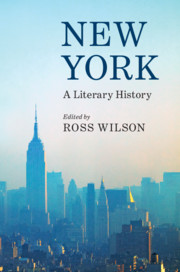Book contents
- New York: A Literary History
- New York
- Copyright page
- Contents
- Contributors
- Acknowledgements
- Chapter 1 Introduction
- Part I Adaptation and Adjustment
- Part II Innovation and Inspiration
- Part III Identity and Place
- Chapter 10 Growing Up in Manhattan
- Chapter 11 Wartime Reading in the City, 1914–1918
- Chapter 12 The Periodical and the Flâneur in Early New York Writing
- Chapter 13 Multiple Voices
- Chapter 14 The New York School?
- Part IV Tragedy and Hope
- Bibliography
- Index
Chapter 10 - Growing Up in Manhattan
Children’s Literature and New York City
from Part III - Identity and Place
Published online by Cambridge University Press: 19 February 2020
- New York: A Literary History
- New York
- Copyright page
- Contents
- Contributors
- Acknowledgements
- Chapter 1 Introduction
- Part I Adaptation and Adjustment
- Part II Innovation and Inspiration
- Part III Identity and Place
- Chapter 10 Growing Up in Manhattan
- Chapter 11 Wartime Reading in the City, 1914–1918
- Chapter 12 The Periodical and the Flâneur in Early New York Writing
- Chapter 13 Multiple Voices
- Chapter 14 The New York School?
- Part IV Tragedy and Hope
- Bibliography
- Index
Summary
This chapter explores how the city’s literature was altered by the advent of the First World War. New York was a metropolis of diverse writing and reading practices before the conflict but the war that erupted in Europe in the summer of 1914 had a direct impact upon the city of New York. Although the United States would not enter what had become a global conflagration by April 1917, New York was directly connected to the nationalistic, political, ethnic and religious tensions that contributed to the conflict. This diversity placed the city under observation by the authorities as they feared that New York could become the site of conflict itself. Whilst fighting between different communities of the city did not occur, the war was fought within the city’s literature. Publishing houses, libraries, newspaper presses and authors across the city mobilised themselves or were rallied to defend other nation’s interests. The city became enmeshed in differences of opinion expressed through novels, political statements, editorials and periodicals. The consequence of the war was to move the city’s literature from a state of alterity to mimesis; reflecting the wider pattern of change within the city at the outset of the twentieth century.
- Type
- Chapter
- Information
- New YorkA Literary History, pp. 139 - 151Publisher: Cambridge University PressPrint publication year: 2020

